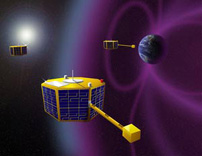Space Technology 5

Space Technology 5 was a NASA project that involved three identical small satellites, functioning as a single 'string-of-pearls' constellation, to test new technologies and accurate multi-point measurement gathering in space. All three micro-sats were built and tested at Goddard Space Flight Center.
The mission was launched on 22 March 2006 by a Pegasus XL rocket from Vandenberg AFB into a near-Earth, Sun-synchronous polar orbit: perigee 300 kilometers (186 miles), apogee 4,500 kilometers (2,796 miles), inclination 105.6°, period 136 minutes. Nominal mission duration was 90 days. On 30 June 2006 the satellites making up ST5 were shut down after successfully completing their technology validation mission.
Each ST5 micro-sat weighed approximately 25 kilograms (55 pounds) when fully fueled and resembled a large birthday cake 53 centimeters (20.7 inches) across and 48 centimeters (18.7 inches) high.
Major technologies include:
Other technologies include:


